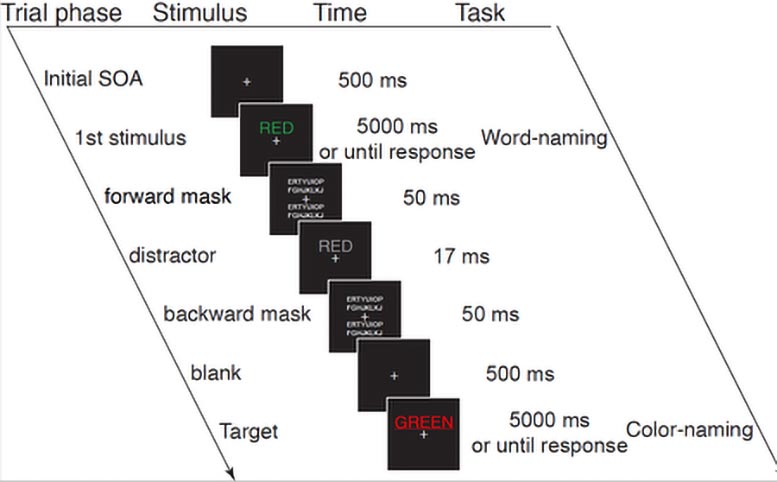Researchers have developed a noninvasive test to detect Alzheimer’s risk, focusing on cognitive processing of distractions. The test, using a Stroop Paradigm, indicates that individuals at high risk for Alzheimer’s process distractions differently, offering a new approach to early detection and understanding of the disease. Credit: SciTechDaily.com
A novel, noninvasive behavioral test by Caltech researchers helps detect early Alzheimer’s risk by analyzing how individuals process distractions, offering a breakthrough in early disease management.
Alzheimer’s disease is a neurodegenerative condition that damages a person’s ability to think, remember, and perform basic functions. According to the National Institutes of Health, Alzheimer’s affects more than 6 million Americans, mostly ages 65 and older. Though the neurological damage from the disease is irreversible, its progression can be slowed by early interventions such as exercise and nutrition regimens. Thus, an early screening for Alzheimer’s risk can be vital in helping people manage and plan for their symptoms.
Challenges in Early Detection
However, before the onset of Alzheimer’s physical symptoms, the primary method to measure an individual’s risk of developing the disease is by measuring levels of certain proteins in cerebrospinal fluid (higher levels indicate higher risk). This test is invasive, painful, and expensive.
Breakthrough in Behavioral Testing
A team from Caltech and the Huntington Medical Research Institutes is currently conducting an ongoing project to develop a simple behavioral test to detect a person’s Alzheimer’s risk, as noninvasive as solving a puzzle on the computer. In 2022, the team developed a behavioral test whose results accurately correlated with spinal fluid measurements.

Another gif demonstration of a typical trial. “Ready” signals the beginning of the trial. Participants are asked to name the color of an underlined word, or name the word itself if it is not underlined. Each trial contains two words, and an ultra-fast noise-masked prime is presented before the second word. “Masking” is one of the ways researchers make things “invisible”—the meaningless symbols occupy the same location as the “invisible” word and flash right before and after the word. The brain focuses on the bright noisy stimulus and only subconsciously processes the hidden word. Credit: Courtesy of S. Hung
Now, the team has used the test to discover more about high-risk individuals’ ability to pay attention and focus. The work, described in a paper published in the journal GeroScience, suggests that high-risk individuals are using their attention to process, rather than suppress, distracting stimuli. The research was conducted in the Caltech laboratory of Shinsuke Shimojo, Gertrude Baltimore Professor of Experimental Psychology. Shimojo is an affiliated faculty member with the Tianqiao and Chrissy Chen Institute for Neuroscience at Caltech.
The Novel Testing Approach
“It has been all the researchers’ dream in the field to come up with a very sensitive psychological paradigm to detect subtle pre-symptoms in the high-risk elderly,” says Shimojo. “However, it was nearly impossible because those high-risk elderly are not diagnosed with the current official standard tests. Our success was owing to two new twists: First, implicit cognitive processing that requires attention. And second, the hypothesis that the cognitive limitation would reveal only under high task load.”
In the test, a participant completes a so-called Stroop Paradigm task. This is a common puzzle in which a person is shown a word—the word is the name of a color—displayed on a computer monitor in colored text. However, the word itself does not necessarily match the color it is displayed in—for example, the word “RED” could be displayed in the color green. In each iteration of the task, the participant is asked to name either the color of the word or the word itself. Compared to naming the word itself, naming the color of the text is considered “high effort”—it is more challenging than it might seem. (You can try it yourself below.)

What does this word say? What color is this word? Is it easier to read the word, or to say its color? Credit: S. Hung
But researchers have also added an extra twist to make the task a bit more challenging. Right before the actual target is shown, a word (white on a white background, and “masked” by several meaningless symbols) is flashed rapidly on the screen—so rapidly that a participant cannot detect it consciously. (See the video to the right of the text for an example.)
The white word—technically called an “implicit distractor”—is intended to unconsciously distract the participant. In addition to conscious and intentional information gathering, which is known as “explicit cognition,” our brains have the ability to process sensory information without conscious awareness. This is known as “implicit cognition.”
Study Findings and Implications
The study involved 36 people with an average age of 75 who were cognitively healthy. Each underwent myriad tests related to Alzheimer’s risk: magnetic resonance imaging (MRI) of the brain, genome sequencing, and the aforementioned invasive cerebrospinal fluid measurements. From these biological markers, individuals could be categorized as high or low risk.
In the 2022 study, the team found that individuals who were at high risk for developing Alzheimer’s (as measured by their spinal-fluid levels) slowed down by about 5 percent with the presence of the implicit distractor in the high-effort condition. This implicit interference was not found in the low-risk individuals. These findings suggest that implicit cognition may be altered years before the onset of any classic Alzheimer’s symptoms.
The new study focused on understanding how the individuals were using their attention during the test. Think of attention as a kind of currency—a finite resource your brain can spend. We all have experienced our attention being distracted from a specific task. Perhaps your phone notifications or a noisy room are distracting your attention from reading this article right now. The team aimed to determine if the high-risk population is using their attention to process the distracting word instead of suppressing the distraction and blocking it out.
“Your brain will unconsciously perceive the distracting word whether you have a high or low risk for Alzheimer’s,” says Shao-Min (Sean) Hung, a former postdoctoral scholar in the Shimojo group, currently an assistant professor at Waseda University in Japan and the study’s co-first author. “But we wanted to study what does your brain do next? Do you use your effort to suppress the distraction or do you use effort to process the distractor? Healthy individuals with low risk of cognitive impairment should be able to suppress the distraction.”
To examine this, the team had the same volunteers complete the task twice, two weeks apart. The idea is that practice reduces the mental load of the task and allows you to have more attention available. For example, if you’re an experienced soccer player, you may be able to easily dribble a ball while using some of your attention to process other things in your environment. But if you’re new to soccer, you need to use a lot of attention and focus to properly dribble the ball. Practice frees up attention for your brain to use elsewhere.
The researchers found that after practicing the task, the low-risk individuals utilize their extra attention to suppress the distracting word and thus are less distracted. On the contrary, the high-risk individuals use their extra attention to process the distracting word—taking in unnecessary information that distracts them from the task at hand and results in stronger interference to their performance. These distractions did not lead to significantly worse performance overall, but the distraction was evident, in that high-risk individuals who had practice effect (faster in the second task) slowed down even more with the presence of the distracting word.
“These results suggest that there is a tight link between implicit cognition and attention, and the changes in implicit cognition in the high-risk population could reflect very early shift in how attention is utilized,” says Hung.
Reference: “Practice makes imperfect: stronger implicit interference with practice in individuals at high risk of developing Alzheimer’s disease” by Shao-Min Hung, Sara W. Adams, Cathleen Molloy, Daw-An Wu, Shinsuke Shimojo and Xianghong Arakaki, 10 October 2023, GeroScience.
DOI: 10.1007/s11357-023-00953-9
Caltech research technician-assistant Sara Adams (BS ’21) is co-first author along with Hung. In addition to Hung, Adams, and Shimojo, other co-authors are Cathleen Molloy and Xianghong Arakaki of the Huntington Medical Research Institutes and Caltech senior scientist Daw-An Wu (PhD ’06). Funding was provided by the James Boswell Postdoctoral Fellowship, a Caltech Biology and Biological Engineering Divisional Postdoctoral Fellowship, and the Aligning Consciousness Research with US Funding Mechanisms by Templeton World Charity Foundation, the Whittier Foundation, and the National Institutes of Health.






